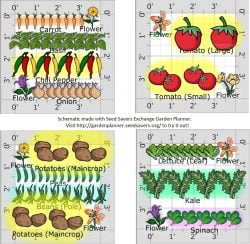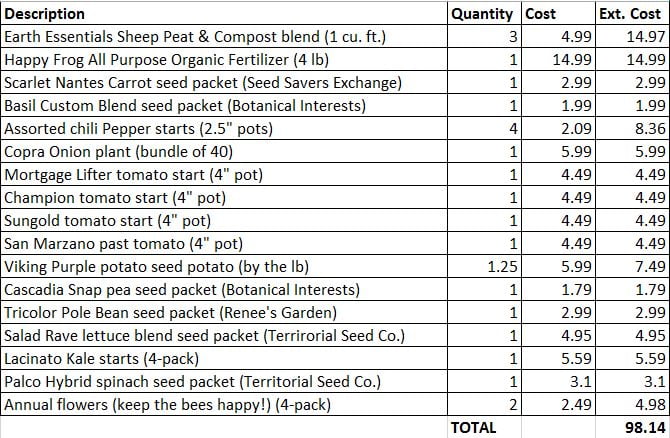I’m going to share a secret with you, one that is well known in the green industry, but not often talked about publicly: You don’t save money by growing your own veggies. Sure, there are exceptions – you can save your seed year after year, collect manure from a friendly farmer, diligently compost every scrap of food waste, collect rain in a barrel, and camp out in the garden to fend off wily pests and invaders. But let’s face the facts, those of us who will willingly give up the many other aspects of our busy lives are few and far between.
So if not for savings, then why? By and large, we do it because we enjoy the crisp snap of a carrot that was pulled from the soil only moments ago. We find something strangely meditative about pulling weeds. We appreciate the convenience of having fresh herbs growing right outside the kitchen. We are enlivened by the connection it gives us with the earth. We love gaining access to obscure varieties of heirloom lettuce that will never grace the produce department of your local grocer. We care about controlling the inputs that ultimately end up in our families’ meals.
Don’t get me wrong, these are all very noble pursuits, but that doesn’t mean we need to stop worrying about the nickels and dimes we spend on the food we grow. Here are my “insider’s tips” on how to stretch your money for maximum yield. We’ll work with a $50 budget.
What to grow from seed
Use seeds for crops which require you to plant lots of plants for a good continued harvest: radishes, lettuce, spinach, carrots, beets, etc. Also use seeds for plants that should be directly sown into the garden. This group includes squash, melons, cucumbers, beans, peas, corn, and any root crop (a crop where the root is the harvest like carrots or onions – transplanting disturbs the roots, which has a magnified effect in root crops). Basically, the idea here is to leave no seeds wasted. Bear in mind that seeds that are started early indoors often require additional materials – grow lights, seedling heat mats, humidity domes, seed starting soil mix, the list goes on.
What to grow from a starter plant
Most home gardens do not allow space for 20 tomato plants, meaning that pile of tiny seeds inside the seed packet will produce far more plants than you need. On top of that, many plants are difficult to start from seed, and even when successful, home-started plants aren’t as sturdy as those grown in commercial greenhouses. For starters, I’ll pay a premium for tomatoes, peppers, eggplants, as well as brassicas (broccoli, cabbage, cauliflower, and Brussel sprouts).
What to buy at the farmer’s market
As I mentioned above, space is often a premium. Some crops take a massive amount of room to grow, and I’m not willing to sacrifice the real estate in my garden for the sake of one crop. In my case, that’s corn. I’ll happily pay a farmer for some good ears of corn, because to successfully grow it at home require a minimum of 16-20 square feet of space. I can harvest an awful lot of carrots and tomatoes from that same amount of garden bed. The same can be argued for aggressive plants like zucchini, pumpkins, and other squash. It all comes down to what a certain crop is worth to you, and what space you can commit to each plant.
My $100 garden
We need to make a few assumptions up front, as everyone’s garden is a little different. Let’s assume I’ve already got four 4’x4’ raised beds with soil from last year’s garden. Here’s my shopping list:
And here’s what my planned layout would be:

It’s fairly basic, no big surprises. We are going to assume I’ve done a soil test and determined I need to add some organic matter (Sheep, Peat, & Compost) and my soil is a little nutrient-poor (Happy Frog All Purpose fertilizer). I tried to combine plants that will work well together: potatoes can happily grow underground while beans and peas climb upwards on trellises. The bed with lettuce, kale, and spinach will appreciate cooler temperatures, so a shadier section of the garden is ideal for this bed. Tomatoes are very hungry plants, so I can fertilize the tomato bed a little heavier than I would any of the other crops without causing any nutrient stress. I always include flowers in my veggie garden. Not only is it easy on the eyes, but it attracts pollinators, who will also visit my veggies like tomatoes and peppers, increasing my yield.
As you can see, it’s possible to pack your space on a budget. The amount you spend will depend on your tastes and space. Plus, there are always additional auxiliary costs – pest control, irrigation, paying the neighbor to water while you’re on vacation – but the benefits are huge. Exercise, fresh air, a safe space for kids to learn about nature, and of course, some tasty produce!
Originally published on March 2nd, 2017.

